信息管理专业英语教程unit8
- 格式:ppt
- 大小:336.00 KB
- 文档页数:20
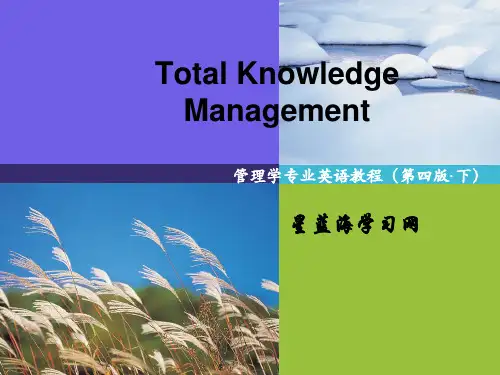
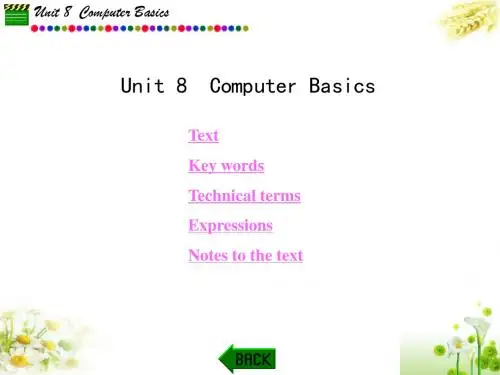
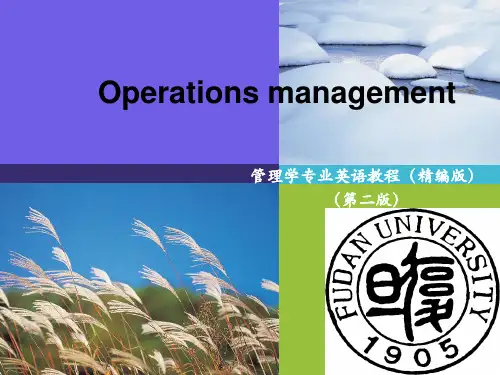
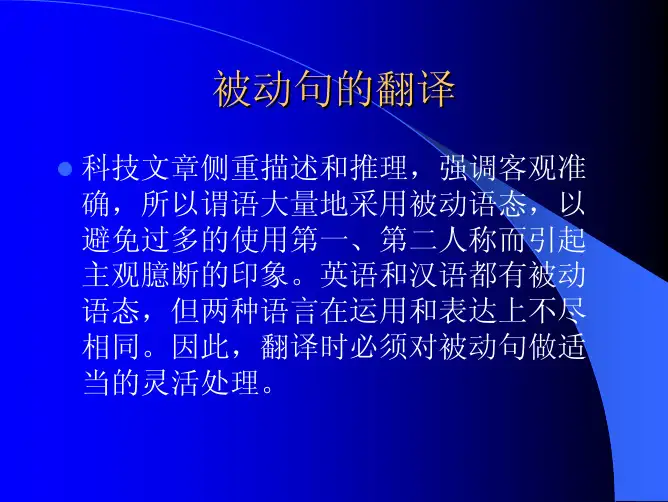
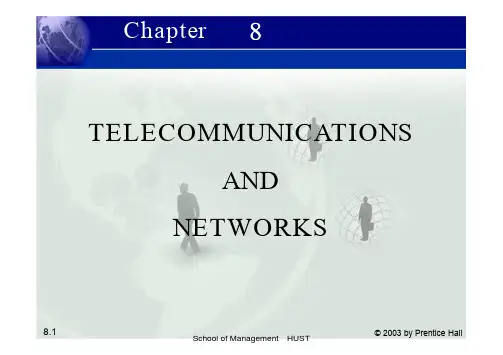
TELECOMMUNICATIONSANDNETWORKSOBJECTIVES•What technologies are used in telecommunications systems?•What telecommunications transmission media should our organization use?•How should our organization design its networks?OBJECTIVES•What alternative network services are available to our organization?•What telecommunications applications can be used for electronic commerce and electronic business?MANAGEMENT CHALLENGES •Managing LANs •Managing bandwidthTHE TELECOMMUNICA TIONS REVOLUTION •Telecommunications:Communication of information by electronic means•The marriage of computers and communications:The 1996Telecommunications Deregulation andReform Act•The Information Superhighway: High-speed digital telecommunicationsnetworks, accessible by the generalpublicCOMPONENTS AND FUNCTIONS OF A TELECOMMUNICA TIONS SYSTEM Telecommunications System Components •Computers to process information•Terminals or any input/output devices that send or receive data •Communications processors •Communications softwareCOMPONENTS AND FUNCTIONS OF A TELECOMMUNICA TIONS SYSTEM Components of a Telecommunications SystemFigure 8-1COMPONENTS AND FUNCTIONS OF A TELECOMMUNICA TIONS SYSTEM Functions of Telecommunications Systems •Transmit information•Establish interface between sender and the receiver•Route messages along most efficient pathsCOMPONENTS AND FUNCTIONS OF A TELECOMMUNICA TIONS SYSTEM Functions of Telecommunications Systems •Perform elementary processing of information•Perform editorial tasks on data•Convert message speed or format•Control flow of informationCOMPONENTS AND FUNCTIONS OF A TELECOMMUNICA TIONS SYSTEM Types of Signals: Analog and DigitalAnalog signal•Continuous waveform•Passes through communications medium •Used for voice communicationsCOMPONENTS AND FUNCTIONS OF A TELECOMMUNICA TIONS SYSTEM Types of Signals: Analog and DigitalDigital signal•Discrete waveform•Transmits data coded into two discrete states as 1-bits and 0-bits•Used for data communicationsModem•Translates computer’s digital signals into analog and vice versaCOMPONENTS AND FUNCTIONS OF A TELECOMMUNICA TIONS SYSTEMFunctions of the ModemFigure 8-2COMPONENTS AND FUNCTIONS OF A TELECOMMUNICA TIONS SYSTEMCommunications Channels•Twisted wire:Telephone systems •Coaxial cable:Cable television•Fiber optics and optical networks: Dense wave division multiplexing (DWDM)COMPONENTS AND FUNCTIONS OF A TELECOMMUNICA TIONS SYSTEMCommunications Channels•Wireless transmission:Microwave, Satellites, Paging systems, Cellulartelephones, Personal communicationServices, Personal digital assistants,Mobile data networks •Transmission:Baud, bandwidthCOMPONENTS AND FUNCTIONS OF A TELECOMMUNICA TIONS SYSTEM Frequency Ranges for Communications Media and DevicesFigure 8-3Figure 8-4COMMUNICA TIONS NETWORKSAmoco’s Satellite Transmission SystemCOMPONENTS AND FUNCTIONS OF A TELECOMMUNICA TIONS SYSTEM Communications Processors and Software•Front-end processor:Manages communications for the host computer•Concentrator:Collects and temporarily stores messages•Controller:Supervises communication traffic•Multiplexer:Enables singlecommunication channel to carry datatransmissionsCOMMUNICA TIONS NETWORKSNetwork Topologies•Star Network:All computers and other devices are connected to a central hostcomputer•Bus Network:Links a number of computers by a single circuit•Ring Network:All computers are linked by a closed loopA Star Network TopologyCOMMUNICA TIONS NETWORKSFigure 8-5A Bus Network TopologyCOMMUNICA TIONS NETWORKSFigure 8-6A Ring Network TopologyCOMMUNICA TIONS NETWORKSCOMMUNICA TIONS NETWORKSPrivate Branch Exchanges, Local Area Networks (LANs), and Wide Area Networks (WANs) Private Branch Exchanges•Central switching system•Handle firm’s voice and digitalcommunicationsCOMMUNICA TIONS NETWORKSPrivate Branch Exchanges, Local Area Networks (LANs), and Wide Area Networks (WANs) Local Area Networks•Telecommunication network•Require its own dedicated channels•Encompass a limited distance•Gateway, router, Network OperatingSystem (NOS), peer-to-peerCOMMUNICA TIONS NETWORKS A Local Area Network (LAN)COMMUNICA TIONS NETWORKSPrivate Branch Exchanges, Local Area Networks (LANs), and Wide Area Networks (WANs) Wide Area Networks (WANs)•Telecommunication network•Span large geographical distance•Consist of variety of cable, satellite, and microwave technologies•Switched lines, dedicated linesValue-Added Networks (VANs)•Private, multipath, data-only, third-party-managed networkOther Network Services•Packet switching, Frame Relay, Asynchronous transfer mode (ATM)•Integrated Services Digital Network (ISDN), Digital subscriber line (DSL), Cable modems, T1 line, Broadband Network Services and Broadband TechnologiesCOMMUNICA TIONS NETWORKSPacked-Switched Networks and Packet CommunicationsCOMMUNICA TIONS NETWORKSCOMMUNICA TIONS NETWORKSNetwork ConvergenceConverged network•Network with technology•Enables voice and data to run over a single networkUnified messaging•System combining voice messages, email, and faxCOMMUNICA TIONS NETWORKSElectronic Commerce and Electronic Business Technologies Electronic Mail and Groupware•E-mail:Eliminates telephone tag and costly long-distance telephone charges •Groupware:Enables work groups at different locations to participate indiscussion forums and work on shared documents and projectsCOMMUNICA TIONS NETWORKSElectronic Commerce and Electronic Business Technologies Voice Mail and Fax•Voice mail:Digitizes spoken message and transmits it over a network •Fax:Digitizes and transmits documents over telephone linesCOMMUNICA TIONS NETWORKSElectronic Commerce and Electronic Business Technologies Teleconferencing, data conferencing, and videoconferencing •Teleconferencing:Ability to confer with a group of people simultaneously •Data conferencing:Two or more users can edit and modify data filessimultaneously •Videoconferencing:Participants are able to see each other over videoscreensCOMMUNICA TIONS NETWORKSElectronic Commerce and Electronic Business Technologies Digital information services, distance learning and E-Learning•Distance learning:Education or training delivered over a distance to individuals in one or more locations•E-learning:Instruction delivered online using the Internet or private networksCOMMUNICA TIONS NETWORKSElectronic Data Interchange•Direct computer-to-computer exchange between two organizations of standard business transaction documentsElectronic Data Interchange (EDI)Figure 8-10COMMUNICA TIONS NETWORKSTELECOMMUNICATIONSANDNETWORKS。
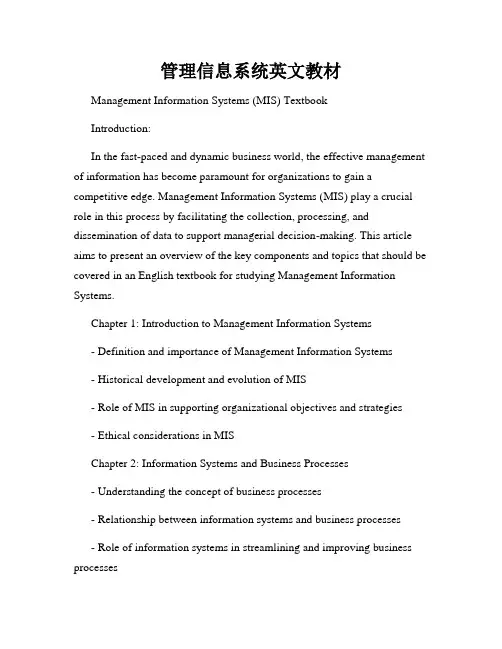
管理信息系统英文教材Management Information Systems (MIS) TextbookIntroduction:In the fast-paced and dynamic business world, the effective management of information has become paramount for organizations to gain a competitive edge. Management Information Systems (MIS) play a crucial role in this process by facilitating the collection, processing, and dissemination of data to support managerial decision-making. This article aims to present an overview of the key components and topics that should be covered in an English textbook for studying Management Information Systems.Chapter 1: Introduction to Management Information Systems- Definition and importance of Management Information Systems- Historical development and evolution of MIS- Role of MIS in supporting organizational objectives and strategies- Ethical considerations in MISChapter 2: Information Systems and Business Processes- Understanding the concept of business processes- Relationship between information systems and business processes- Role of information systems in streamlining and improving business processes- Case studies illustrating the impact of information systems on business efficiencyChapter 3: Data and Information Management- Difference between data and information- Data storage and retrieval systems- Database management systems and their importance in MIS- Data governance and data quality managementChapter 4: Information Systems Infrastructure- Components and architecture of an information systems infrastructure- Hardware, software, and network resources used in MIS- Cloud computing and its role in information systems infrastructure- Security considerations in managing an information systems infrastructureChapter 5: Business Intelligence and Analytics- Concept and benefits of business intelligence (BI)- Techniques and tools used in BI and data analytics- Application of BI in decision-making processes- Predictive analytics and its role in strategic planningChapter 6: Enterprise Systems- Overview of enterprise systems (ERP, CRM, SCM)- Integration of enterprise systems and their benefits- Case studies showcasing the successful implementation of enterprise systems- Challenges and risks associated with implementing enterprise systemsChapter 7: E-commerce and E-business- Introduction to e-commerce and e-business models- Role of information systems in supporting online transactions- Security and privacy concerns in e-commerce- Mobile commerce and its impact on business operationsChapter 8: Social, Ethical, and Legal Issues in MIS- Ethical considerations in the use of information systems- Legal frameworks and regulations governing MIS usage- Privacy and security issues in managing information systems- Social implications of MIS and its impact on societyConclusion:A comprehensive and well-structured English textbook on Management Information Systems is vital for students to grasp the fundamental concepts and principles underlying the effective management of information in organizations. By covering topics such as MIS introduction, information systems and business processes, data management, information systems infrastructure, business intelligence and analytics, enterprise systems, e-commerce and e-business, and social, ethical, and legal issues, this textbook equips students with the necessary knowledge and skills to excel in the field of MIS.。
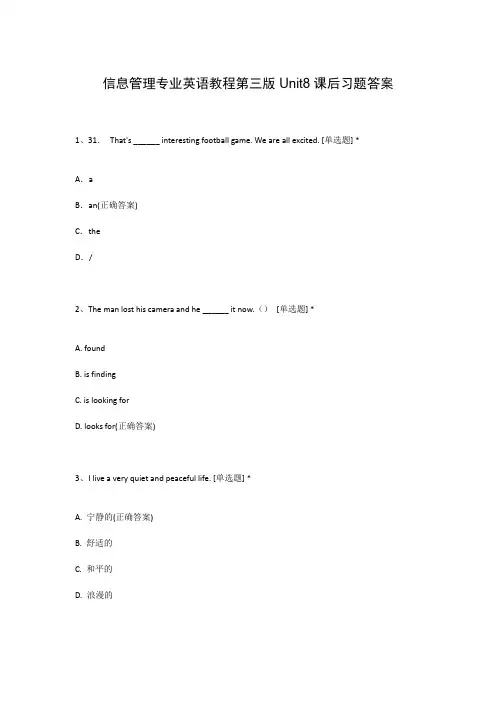
信息管理专业英语教程第三版Unit8课后习题答案1、31.That's ______ interesting football game. We are all excited. [单选题] *A.aB.an(正确答案)C.theD./2、The man lost his camera and he ______ it now.()[单选题] *A. foundB. is findingC. is looking forD. looks for(正确答案)3、I live a very quiet and peaceful life. [单选题] *A. 宁静的(正确答案)B. 舒适的C. 和平的D. 浪漫的4、16.Lily is a lovely girl. We all want to ________ friends with her. [单选题] *A.haveB.make(正确答案)C.doD.take5、—What ______ your sister ______ this Saturday?—Something special, because it’s her birthday. ()[单选题] *A. are; going to doB. is; going to do(正确答案)C. does; doD. did do6、More than one student_____absent from the class yesterday due to the flu. [单选题] *A.areB.hasC.isD.was(正确答案)7、85.You’d better? ? ? ? ? a taxi, or you’ll be late. [单选题] *A.take(正确答案)B.takingC.tookD.to take8、I hope to see you again _______. [单选题] *A. long long agoB. long beforeC. before long(正确答案)D. long9、95--Where and when _______ you _______ it? [单选题] *A. did; buy(正确答案)B. do; buyC. have; boughtD. will; buy10、He prefers to use the word “strange”to describe the way()she walks. [单选题] *A. in which(正确答案)B. by whichC. in thatD. by that11、His mother’s _______ was a great blow to him. [单选题] *A. diedB. deadC. death(正确答案)D. die12、The Internet is an important means of()[单选题] *A. conversationB. communication(正确答案)C. speechD. language13、76.—Could you tell me ________the bank?—Turn right and it's on your right. [单选题]* A.how get toB.how to getC.how getting toD.how to get to(正确答案)14、If people _____ overanxious about remembering something, they will forget it. [单选题] *A. will beB. would beC. wereD. are(正确答案)15、Sorry, I can't accept your invitation. [单选题] *A. 礼物B. 观点C. 邀请(正确答案)D. 好意16、A?pen _______ writing. [单选题] *A. is used toB. used toC. is used for(正确答案)D. used for17、How can I _______ the nearest supermarket? [单选题] *A. get offB. get upC. get to(正确答案)D. get on18、Jim wants to hang out with his friends at night, but his parents don’t allow him ______ so. ()[单选题] *A. doB. doneC. to do(正确答案)D. doing19、49.________ is the price of the product? [单选题] *A.HowB.How muchC.What(正确答案)D.How many20、---Excuse me sir, where is Room 301?---Just a minute. I’ll have Bob ____you to your room. [单选题] *A. show(正确答案)B. showsC. to showD. showing21、____ is standing at the corner of the street. [单选题] *A. A policeB. The policeC. PoliceD. A policeman(正确答案)22、E-mail is _______ than express mail, so I usually email my friends. [单选题] *A. fastB. faster(正确答案)C. the fastestD. more faster23、This message is _______. We are all _______ at it. [单选题] *A. surprising; surprisingB. surprised; surprisedC. surprising; surprised(正确答案)D. surprised; surprising24、You can't rely on Jane as she is _____ changing her mind and you will never know what she isgoing to do next. [单选题] *A. occasionallyB. rarelyC. scarcelyD. constantly(正确答案)25、Have you done something _______ on the weekends? [单选题] *A. special(正确答案)B. soreC. convenientD. slim26、—Can you play tennis? —______, but I’m good at football.()[单选题] *A. Yes, I can(正确答案)B. Yes, I doC. No, I can’tD. No, I don’t27、—Where are you going, Tom? —To Bill's workshop. The engine of my car needs _____. [单选题] *A. repairing(正确答案)B. repairedC. repairD. to repair28、_____ to wait for hours,she brought along a book to read. [单选题] *A. ExpectedB. Expecting(正确答案)C. ExpectsD. To expect29、_____ yuan a month _____ not enough for a family of three to live on today. [单选题] *A. Five hundred; is(正确答案)B. Five hundreds; areC. Five hundred; areD.Five hundreds; is30、We are very hungry now. Can you _______ us something to eat? [单选题] *A. carryB. takeC. borrowD. bring(正确答案)。

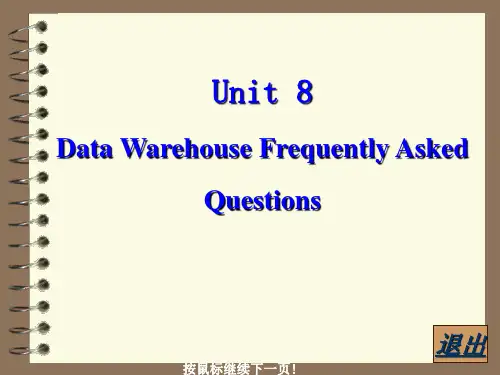
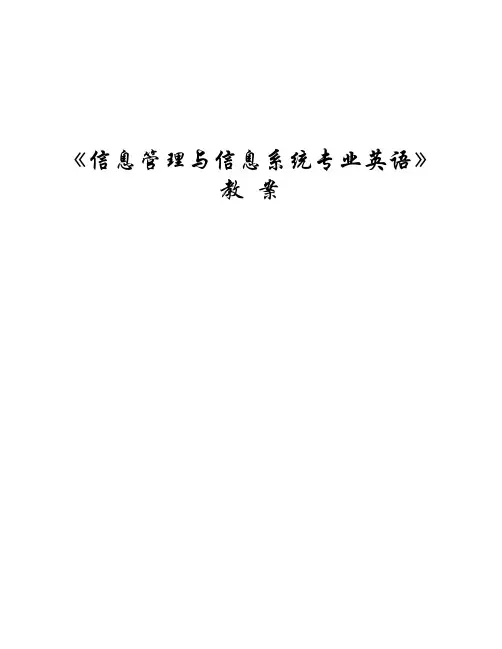
《信息管理与信息系统专业英语》教 案目录Unit 1 Management Information SystemUnit 2 Information Systems and OrganizationsUnit 3 Database Management SystemsUnit 4 Management Information Systems Development Unit 5 Systems’ Success and FailureUnit 6 Application of Information SystemsUnit 7 Decision Support SystemsUnit 8 Information SecurityUnit 9 Internet EconomyUnit 10 Knowledge ManagementUnit 11 Data MiningUnit 12 Data Warehouse and OLAPUnit 1 Management Information System教学目的及要求1.掌握本单元的专业词汇;2.理解并掌握文中复杂句子所涉及的语法知识;3.流利朗读及翻译课文;4.了解与管理信息系统的基本概念。
主要教学内容授课方式学时分配Text 课堂讲授2学时New WordsPhrases AbbreviationsNotesQuestions for Discussion 课堂讲授课堂讲授课堂讲授课堂讲授课堂讨论1学时Supplementary Reading 引导自学1学时Material for Self-study 学生自学—教学重点与难点[教学重点]:掌握与本文相关的重点词汇,了解管理信息系统的基础知识。
[教学难点]:专业词汇的识别及记忆,连词+过去分词的用法。
教学手段以学生朗读、翻译为主,教师对重点专业词汇及较难懂的句子给以讲述;教师引导学生进行思考题的讨论,锻炼学生的口语表述能力和对专业知识的理解。
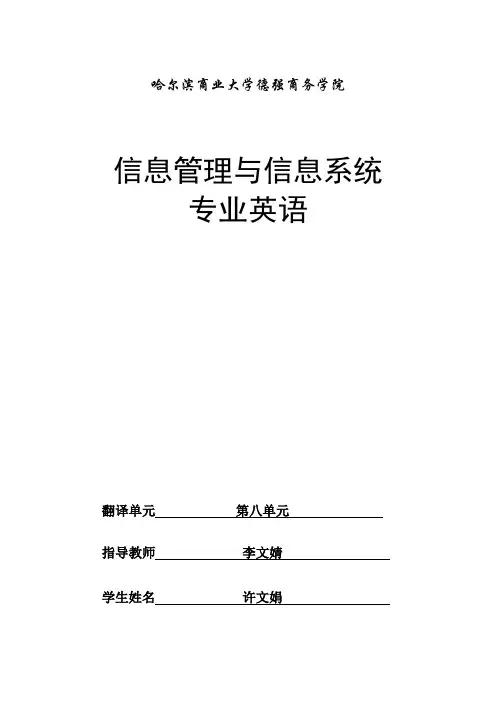
哈尔滨商业大学德强商务学院信息管理与信息系统专业英语翻译单元第八单元指导教师李文婧学生姓名许文娟第四章管理信息系统的发展历程概要:(1):发展中的现行系统的数据流程图。
(2):逻辑过程用于决策树和决策表。
正文:结构系统的分析和设计的主要目标是,以确定确切的制度,使“正确”的系统设计要求。
结构化方法,采用了一系列的图形工具和技术,用户完全可以理解。
这种方法策略使得系统的分析人员可以在错误被输入系统发展历程的设计和后续阶段之前的分析阶段捕获它们。
如果错误是在分析阶段的一个项目,是很多次批改。
例如,如果一个必要的数据元素是在分析阶段确定,它可能是左边的系统文件,在设计阶段。
一旦系统运行时,用户可能会注意到,从报告中缺少某些信息。
设计师可以了解情况,并找出一个数据元素是由一个主文件丢失。
重新设计的文件和报告,将远远超过数据元素,数据字典项目的分析阶段。
结构系统的分析过程,有助于早期分析捕获错误。
结构化系统分析方法运用工具描绘了让用户可以清楚的理解的当期系统和推荐的系统逻辑模型,而不是向用户提供他们看不懂的系统说明书。
图表4.1是系统发展中的结构化方案与传统方案的对比。
传统的方案需要里了解现行系统的数据文件,报告,程序,决策,并且为系统开发自动化的版本。
虽然这种方案也很高效,无效的现行系统有一种趋于自动化的趋势,在现在的形势下报道可以没有原因的被写出来。
申请者的信息可以是不完整的,过时的废弃的,或者简单的不准确的。
如果现行系统是自动化的,很多的这些问题就不会被发现(就是不会出现这些问题)。
相反的,在结构化的系统分析与设计中,分析人员收集现行的程序,信息流,决策制定过程的信息,并且报道和建立现在情形的逻辑模型,使用一个叫逻辑数据流程图的工具。
图表4.1系统发展中的结构化方案与传统方案的对比使用数据流程图是因为它描述了业务流程逻辑,信息需求和信息流。
而不是系统的这些元素的物理视图。
用户不需要知道他们的个人记录是否都存储在磁带文件,磁盘文件或者纸质文件中。
信息管理专业英语实用教程——清华大学出版社1~10单元的课后英译汉答案Unit 11. Management is the attainment of organizational goals in an effective and efficient manner through planning, organizing, leading, and controlling organizational resources.管理是组织目标通过计划、组织、领导、控制组织资源实现的有效方式。
2. Planning defines where the organization wants to be in the future and how to get there.计划决定了组织将来的发展方向和实现方式。
3. Organization failure can occur when managers are not serious about control or lack control information.组织的失败往往在管理人员不认真对待控制或缺乏控制的信息时发生。
4. The ultimate responsibility of managers is to achieve high performance, which is the attainment of organizational goals by using resources in an efficient and effective manner.管理人员的最终责任是获得高业绩,这是组织目标实现的一种有效的利用资源和有效的方式。
5. There are no “peopleless”organizations, so managers must learn how to motivate, lead and communicate; they must also understand interpersonal relations and the behavior of groups of people.没有任何“peopleless”组织,所以经理们必须学会如何激励、领导和交流,他们也必须理解人际关系和各种人群的行为。
.教案首页(第9次课,2学时)授课题目Unit 8 Network教学目的通过讲授,使学生了解网络分类以及OSI协议的英语术语与要求教学重点网络分类专业术语教学难点课文的理解、翻译教学内容:单词、课文教学过程教学方法:讲授法课后作业P105-118,1-5教学后记Unit 8 Network一、基础知识1。
计算机网络是将地理位置不同并具有独立功能的多个计算机系统通过通信设备和线路连接起来,并通过网络软件实现网络资源共享的系统。
2.计算机网络协议ISO(国际标准化组织)提出计算机网络开放系统互联模型(Open Systems Interconnection),称为OSI模型。
分为七个层次,分别是:应用层:提供与用户应用有关的功能,如网络浏览、电子邮件。
表示层:提供由应用层选择的一组特定服务,对交换数据的含义进行解释。
如:数据格式转换。
会话层:进行高层通信控制,允许在不同计算机上的用户建立通信运输层:从会层接收数据,分成较小的单元传输,并确保信息准确。
网络层:传输中路由选择和流量控制。
数据链路层:为网络中两端建立、维持和释放数据链路。
物理层:物理连接。
3.网络分类局域网:覆盖小范围的网络广域网:大范围的网络Internet:全球范围的网络二、New Words1.adapter适配器2. alternative a.两者择一的,另类的n. 供选择的事物Find alternative means of transport另找一个运输方法One of the alternatives open to you is to resign.你辞职也是一种方法。
3. application-specific a.特定供应的4. cable n.缆绳,电缆,(海底)电报vt.给…发电报Send sb a cable给某人拍电报News of his death was cabledto his family.他的死讯已电报给他的家属。